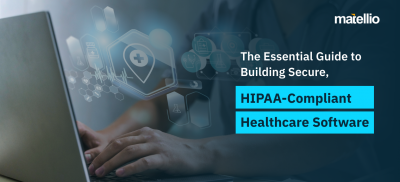
The need for accessible and effective mental health care has never been greater. Today, navigating the complexities of diagnosis, treatment, and ongoing support requires human empathy and technological innovation. While skilled professionals are the cornerstone of mental health care, mental health emr software designed specifically for mental health needs can be powerful allies in the fight for better patient outcomes.
This is the vision that drives innovation in mental health EMR software development. These innovative solutions have transformed how mental health professionals track patient data, manage treatment plans, and communicate with their peers. As the demand for mental health services continues to rise, the need for efficient and effective EMR software tailored to the unique needs of mental health practitioners has never been greater.
This blog delves deeper into the transformative potential of this technology. Whether you’re a mental health professional looking to maximize your impact, a patient seeking the right resources, or simply an interested observer, this blog offers valuable insights into the changing landscape of mental health care and the role of technology in creating a brighter future for all.

Features of Mental Health EMR Software
Mental health emr software tailored for mental health practices is crucial in streamlining patient care, ensuring compliance, and improving overall practice efficiency. Here are some key features typically found in mental health EMR software.
 Patient Scheduling
Patient Scheduling
Users can easily schedule, reschedule, or cancel appointments. The emr software for mental health syncs with providers’ calendars for real-time scheduling updates. It can send appointment reminders to reduce no-shows.
 Patient Charting
Patient Charting
Users can use pre-built or create custom templates for various mental health assessments and treatment plans. Users can Document patient encounters and treatment progress. Users can monitor patient outcomes over time.
 Billing and Insurance
Billing and Insurance
Users can verify patient insurance coverage and benefits. Users can submit claims electronically for faster processing. Users can accept and process payments, including co-pays and deductibles.
 Prescription Management
Prescription Management
Users can electronically send prescriptions to pharmacies. Users can track and manage patient medications, including dosage and refills. Users can also check for potential drug interactions and allergies.
 Telehealth Integration
Telehealth Integration
Users can conduct secure video consultations with patients. Users can also monitor patients remotely, especially for ongoing mental health care.
 Clinical Decision Support
Clinical Decision Support
Users can access evidence-based guidelines and protocols for treatment decisions. Users can use tools for assessing suicide risk, depression severity, and other mental health parameters.
 HIPAA Compliance
HIPAA Compliance
Users can ensure patient data is secure and compliant with HIPAA regulations. Users can also maintain audit logs for all interactions with patient data.
 Interoperability
Interoperability
Users can exchange data with labs and pharmacies for seamless care coordination. Users can share patient information securely with other healthcare providers.
 Patient Portal
Patient Portal
Users can allow patients to communicate securely with providers. Users can provide patients with access to their medical records and treatment plans.
Read More: How to Build a Patient Portal Software for the Medical Practices?
 Reporting and Analytics
Reporting and Analytics
Users can generate reports on patient outcomes and treatment effectiveness. Users can also track practice performance and revenue.
Mental health EMR software offers a range of features designed to enhance the quality of care, streamline practice operations, and ensure compliance with regulatory requirements. By leveraging digital transformation services, mental health practices can improve patient outcomes and enhance efficiency.
Use Cases of Mental Health EMR Software
Mental health emr software has revolutionized how mental health practitioners manage patient information and deliver care. Here are some key use cases highlighting the benefits and versatility of emr software for mental health:
Centralized Patient Records
Mental Health EMR software centralizes patient records, including diagnostic information, treatment history, medications, and progress notes, allowing for easy access and comprehensive care planning. A psychiatrist can quickly access a patient’s treatment history, helping them make informed decisions about ongoing care.
Streamlined Appointment Scheduling
EMR software for mental health allows seamless appointment scheduling, reducing administrative burden and ensuring patients receive timely care. A mental health clinic can use the software to schedule follow-up appointments and send automated reminders to patients, reducing no-show rates.
Also Read: How to Develop Mental Health Practice Management Software?
Telehealth Integration
Integrating telehealth features into mental health emr software enables mental health providers to conduct virtual appointments, improving access to care for patients in remote or underserved areas. A therapist can show a video therapy session with a patient who cannot attend an in-person appointment, maintaining continuity of care.
Billing and Insurance Management:
emr software for mental health simplifies billing and insurance management, reducing errors and ensuring timely reimbursement for services rendered. A mental health clinic can use the software to generate accurate billing statements and submit claims electronically, speeding up the reimbursement process.
Outcome Tracking and Reporting:
Mental Health EMR software allows providers to track patient outcomes over time, helping them assess the effectiveness of treatments and make data-driven decisions. A psychologist can use the software to track a patient’s progress in therapy and adjust the treatment plan as needed based on outcome data.
Interoperability with Other Systems
Mental health EMR software that is interoperable with other healthcare systems allows for seamless sharing of patient information, facilitating collaborative care. A psychiatrist can securely share patient information with a primary care physician to ensure coordinated care for patients with comorbid conditions.
Clinical Decision Support
EMR software for mental health provides clinical decision support tools, such as alerts for drug interactions or treatment guidelines, helping providers deliver safe and effective care. A psychiatric nurse practitioner can use the software to check for potential drug interactions before prescribing medication to a patient.
Patient Engagement and Education
EMR software for mental health facilitates patient engagement through secure messaging, educational resources, and treatment plan reminders, empowering patients to take an active role in their care. A mental health provider can use the software to send psychoeducation materials to a patient to help them better understand their condition and treatment options.
Professional healthcare software development services play a crucial role in innovating the mental health emr software for quality care of patients with mental health conditions, by streamlining administrative processes for providers, and fostering collaboration among healthcare professionals. Its diverse use cases highlight its importance in modern mental health care delivery.
Best Practices for Developing Mental Health EMR Software
Developing EMR software for mental health requires a nuanced approach to ensure patient care’s security, privacy, and effectiveness. Here are some best practices for mental health EMR software development:
Compliance with Regulatory Standards: Ensure the mental health emr software meets the Health Insurance Portability and Accountability Act (HIPAA) standards for protecting patient health information. Adhere to other relevant regulations and standards, such as the HITECH Act and GDPR, depending on the region of use.
User-Centric Design: Design emr software for mental health with an intuitive user interface (UI) that is easy for mental health professionals to navigate. Allow for software customization to meet the unique needs of different mental health practices.
Security and Privacy: Use strong encryption methods to protect patient data in transit and at rest. Implement strict access controls to ensure only authorized personnel can access patient information. Maintain detailed audit logs of access and modifications to patient records for accountability.
Interoperability: Ensure that the software can integrate with other systems, such as pharmacies and labs, to facilitate seamless information exchange. Use standards like HL7 and FHIR to enable interoperability with other healthcare systems.
Clinical Decision Support: Incorporate alerts and reminders to help mental health professionals adhere to best practices and guidelines. Provide support for evidence-based treatment guidelines to assist clinicians in making informed decisions.
Telehealth and Remote Monitoring:
Enable telehealth capabilities to allow for remote consultations and therapy sessions. Support remote monitoring of patient progress and vital signs to facilitate ongoing care.
Also Read: Telehealth App Development: Everything You Need to Know for the Journey
Scalability and Performance:
Design the mental health emr software with a scalable architecture to accommodate growth in the number of patients and users. Optimize the software’s performance to ensure responsiveness and reliability.
Training and Support: Provide comprehensive training to mental health professionals on how to use the software effectively. Offer reliable technical support to address any issues that users may encounter.
Continuous Improvement: Establish a feedback mechanism to gather user input and incorporate it into future updates. Release regular updates to the software to address bugs and security vulnerabilities and to introduce new features based on user feedback and industry trends.
Developing mental health EMR software requires to hire dedicated developers for careful balance of usability, security, and compliance to ensure that it meets the needs of mental health professionals and facilitates high-quality patient care. By following these best practices, dedicated developers can create software that supports mental health professionals in delivering effective and compassionate patient care.
Technology Trends in Mental Health EMR Software
Mental health EMR software tailored for mental health providers is continuously evolving to meet the unique needs of this specialized field. Here are some key technology trends shaping the development of Mental Health EMR software:
Telehealth Integration
Telehealth has revolutionized mental health care delivery, especially during the COVID-19 pandemic. EMR software for mental health integrates seamlessly with telehealth platforms, allowing providers to conduct virtual sessions, prescribe medication electronically, and monitor patient progress remotely.
Artificial Intelligence and Machine Learning
AI and ML algorithms are increasingly integrated into mental health EMR software to analyze patient data, identify patterns, and provide personalized treatment recommendations. These technologies can help improve diagnosis accuracy, treatment planning, and patient outcomes.
Also Read: Digital Transformation in Healthcare
Mobile Applications
Mobile apps are becoming essential tools for mental health providers and patients alike. Mental health EMR software offers mobile applications that allow patients to access therapy resources, track their mood, and communicate with their providers securely.
Blockchain for Data Security
Blockchain technology is being explored for its potential to enhance data security and privacy in mental health EMR systems. It offers a decentralized and tamper-proof method of storing patient records, ensuring confidentiality and integrity.
Explore More: Power of EMR Systems
Interoperability and Data Sharing
Interoperability remains a key focus in mental health EMR software development, allowing mental health providers to share patient data securely with other healthcare providers and systems. This enables better care coordination and continuity of care.
Enhanced Data Analytics
Advanced data analytics tools are being integrated into EMR software for mental health to help providers gain insights from large datasets. These tools can assist in identifying trends, predicting patient outcomes, and improving treatment strategies.
Virtual Reality Therapy
VR therapy is emerging as a promising treatment modality for various mental health conditions. Healthcare software developers are exploring ways to integrate VR technology into mental health emr software to support providers offering this innovative therapy.
Personalized Medicine
EMR software for mental health increasingly focuses on personalized medicine approaches, leveraging patient data and genetic information to tailor treatment plans to individual patients. This can lead to more effective and targeted interventions.
Patient Engagement Tools
Patient engagement is crucial in mental health care. Mental health EMR software includes patient portals, secure messaging, and educational resources to empower patients to participate actively in treatment.
Ethical and Legal Considerations
With the integration of advanced technologies, healthcare developers address ethical and legal considerations, such as data privacy and consent, and ensure the responsible use of AI in mental health care.
EHR software development is evolving to embrace technology trends that enhance care delivery, improve patient outcomes, and streamline administrative processes. By leveraging these advancements, mental health providers can offer more personalized, accessible, and effective care to their patients.
Development Steps of Mental Health EMR Software
Developing EMR software tailored to the unique needs of mental health professionals involves a thoughtful and systematic approach. Here’s an overview of the development process:
 Requirements Gathering
Requirements Gathering
Engage with mental health professionals, including psychiatrists, psychologists, and therapists, to understand their needs and workflow requirements. Ensure the software meets regulatory standards such as HIPAA for patient data protection.
 Design
Design
Design an intuitive and user-friendly interface that facilitates easy navigation and data entry. Develop a database schema that efficiently stores and retrieves patient records, including diagnostic assessments, treatment plans, and progress notes. Implement robust security measures to protect patient data, including encryption, access controls, and audit logs.
 Development
Development
Implement the UI design using technologies like HTML, CSS, and JavaScript. Develop the backend logic to handle data processing, storage, and retrieval, using languages like Python, Java, or Node.js. Integrate with third-party tools and services, such as billing software or telehealth platforms, to enhance functionality.
 Testing
Testing
Test individual components of the software to ensure they function correctly. Test the integration of different modules to verify they work together seamlessly. Invite mental health professionals to test the software in a real-world environment to validate its functionality.
 Deployment
Deployment
Plan the deployment strategy, considering factors like user training and data migration. Install the software on the designated servers or cloud infrastructure. Configure the software based on the mental health practice’s specific requirements.
 Training and Documentation
Training and Documentation
Provide training sessions for mental health professionals to familiarize them with the software. Create user manuals and documentation for reference.
 Maintenance and Support
Maintenance and Support
Provide ongoing maintenance to fix bugs and release updates with new features. Use technical support to help users troubleshoot issues and optimize their use of the software.
 Feedback and Iteration
Feedback and Iteration
Gather feedback from users to identify areas for improvement. Use feedback to iterate on the software, adding new features and enhancing existing ones.
Developing mental health EMR software requires a thorough understanding of mental health practices and regulatory requirements and a focus on usability and security. Following a structured development process ensures the software meets the needs of mental health professionals and contributes to improved patient care.
Conclusion
Mental health EMR software isn’t just about streamlining documentation; it’s about unlocking deeper connections, fostering empowered care, and paving the way for a brighter future for mental health.
EMR software for mental health represents a pivotal advancement in mental healthcare. It streamlines clinical workflows, enhances patient care, and improves overall efficiency in mental health practices. By providing secure access to comprehensive patient records, enabling personalized treatment plans, and facilitating communication between providers and patients, mental health EMR software is transforming how mental healthcare is delivered. As technology evolves, mental health EMR software will likely play an increasingly vital role in improving mental health outcomes and ensuring patients receive the care they need.
FAQs
What is Mental Health EMR Software?
Mental Health EMR (Electronic Medical Record) software is a digital platform designed to store, manage, and share patient information related to mental health care. It includes features for documenting patient encounters, tracking treatment progress, and ensuring compliance with regulations.
How long does it take to develop Mental Health EMR Software?
The development timeline for Mental Health EMR software can vary depending on the project's complexity, the availability of resources, and the extent of customization required.
What trends are shaping the future of Mental Health EMR Software development?
Trends shaping the future of Mental Health EMR software development include:
The use of artificial intelligence (AI) and machine learning for personalized treatment recommendations.
The integration of telehealth services for virtual care delivery.
The development of mobile applications for remote patient monitoring and self-care.
How much does it cost to develop Mental Health EMR Software?
The cost of developing Mental Health EMR software can vary widely depending on factors such as the project's scope, the software's complexity, and the development team's rates.
 Patient Scheduling
Patient Scheduling Patient Charting
Patient Charting Billing and Insurance
Billing and Insurance Prescription Management
Prescription Management Telehealth Integration
Telehealth Integration Clinical Decision Support
Clinical Decision Support HIPAA Compliance
HIPAA Compliance Interoperability
Interoperability Patient Portal
Patient Portal Reporting and Analytics
Reporting and Analytics


 Requirements Gathering
Requirements Gathering Design
Design Development
Development
 Deployment
Deployment Training and Documentation
Training and Documentation Maintenance and Support
Maintenance and Support Feedback and Iteration
Feedback and Iteration

